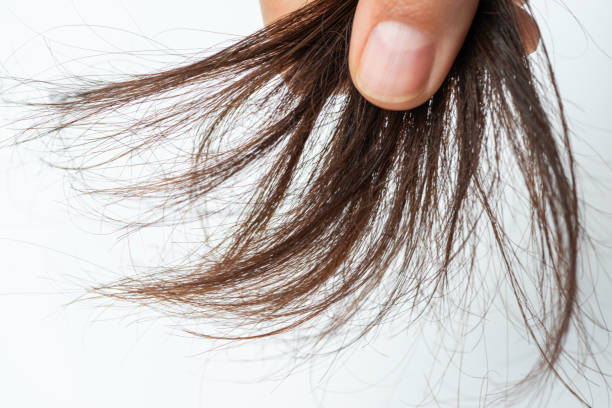Deep conditioning can make your hair softer and more manageable if you have dry hair.
Deanne Mraz Robinson, MD, FAAD, is the president and co-founder of Modern Dermatology and assistant clinical professor at Yale New Haven Hospital.
What you need to consider when choosing a deep conditioner to keep your hair moisturized.
Why does hair become dry?
The amount of sebum produced by your sebaceous glands will determine the moisture level in your hair. Sebum, an oil, lubricates skin, hair, and scalp.
The amount of scalp sebum produced varies between people and changes over time. Mraz Robinson says that your age, hormones, stress, and environmental triggers can affect the amount of sebum produced by the scalp.
Mraz Robinson explains that this can cause strands to become porous and dry.
Heat styling can also dry your hair out. If you constantly reach for the blow dryer and curling irons, it may be time to consider adding deep conditioning to your routine.
Mraz Robinson explains that deep conditioners have more emollients and humectants than daily conditioners. Mraz Robinson says deep conditioners are left on the hair much more extended than daily conditioners: up to 30 minutes instead of 2 or 3.
Mraz Robinson says that deep conditioners have a heavier, thicker concentration. They may continue to work for several days since they penetrate more deeply into the hair than daily conditioners that smoothen and condition only the surface.
Deep Conditioning: Benefits
Both deep conditioners and regular conditioners enhance the appearance of hair. Deep conditioners are more visible. They can:
- detangle hair
- Reduce frizz
- Boost shine
- Increase smoothness
Who needs a deep conditioner?
As shampoos also remove sebum from hair, the American Academy of Dermatology suggests using a quick-rinse conditioner after every wash.
Mraz Robinson suggests that unless you have particularly oily hair, you may benefit from using a deep conditioning treatment.
She says that the frequency of deep conditioning depends on the texture of your hair and how frequently you wash it and heat style it.
Mraz Robinson states that using the product too often could cause it to build up.
Sebum is easily absorbed by straight hair and lubricates it. People with tight curls will need to condition their hair deep more frequently.
You should also deep condition your hair prior to getting it treated chemically (e.g., straightened or permed).
How deep condition can be done at home?
Mraz Robinson suggests that you take the following steps.
- Only shampoo if you need to. If your scalp is not oily or dirty, skip the shampoo and go straight to your deep conditioner.
- Use deep conditioner based on the type of hair you have. For dry hair or curls that are tight, it’s best to apply the conditioner as close as possible, if not at the root. Use deep conditioner on the mid-shaft and ends of your hair if your hair is greasy. Keep your regular conditioner close to your scalp if your hair tends to be oilier.
- Comb out the product. Use your fingers or a comb with a wide-toothed comb to cover all of your hair strands. She notes that most people will apply the product to the lower portion of their hair and concentrate on the ends.
- Read the packaging for instructions. Instructions may vary. She would recommend leaving it on between 20 and 30 minutes.
- Rinse your hair with cool water. This will seal in the goodness.
- Mraz Robinson recommends these products:
- undefined
- Undefined. It conditions the ends so you can go longer between haircuts.
- Olaplex Hair Perfector no. She recommends the 3 Repairing Treatments for colored hair.
A word of caution
- You should be careful if your scalp is sensitive, especially if it has eczema and Psoriasis.
- Mraz Robinson warns that “many of these treatments contain strong fragrances and could cause a flare up of your condition.”
- She says that if you are acne prone, keep newly conditioned hair away from your face and replace your pillowcases regularly.
The Bottom Line
- Deep conditioners are more concentrated in emollients and humectants and remain on the hair longer than daily conditioners.
- Most people can use a deep conditioner once per week. Brush from the middle of the shaft to the ends. Leave on for 20 mins, then rinse with cool, fresh water.
- Dry hair does not mean you are suffering from a severe health issue or that your hair is damaged.
- Smoking, sun exposure, heat styling, and humidity can all cause hair to become damaged and dry. Here are a few tips on how to care for dry hair.
- Trim up your hair
- A fresh cut might be needed if your hair feels too dry. Split ends, even if they aren’t long enough to be noticeable, can make your hair feel dry and coarse.
- Trim unhealthy hair to encourage new hair growth. Ask the stylist for tips on managing your hair length and type. The stylist may suggest a unique style to prevent your hair from getting damaged.
- Take Vitamins
- Specific vitamins also have a direct impact on the health of hair and nails. The minerals iron, Biotin, and Vitamin C all help to make hair look healthier.
- Some people take prenatal vitamins just because they have all the vitamins listed above. It is also trendy to take supplements containing only Biotin to improve the appearance of your hair. Recent researchTrustedSource does not support the idea that Biotin is a significant factor. Consider taking marine protein supplements. It has been proven to make hair healthier.
- Wash your hair less often.
- Sebum is stripped from the hair by shampoo. Sebum, a natural oil, makes hair easier to maintain. It also gives it a shiny appearance when the amount is correct. Sebum in excess can make hair look greasy.

